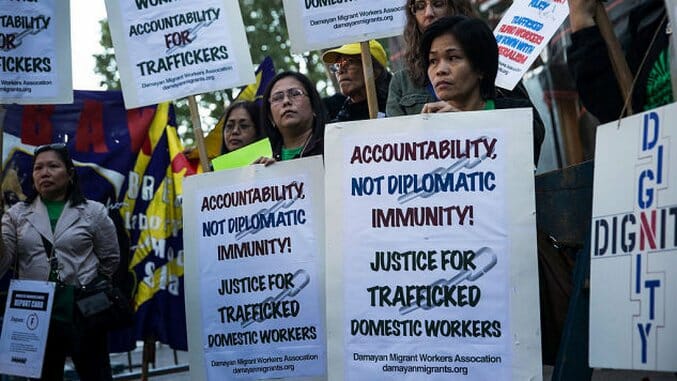Study Finds There Are 40 Million Slaves in the World
Of human bondage
Andrew Burton / Getty Politics Features Slavery
Slavery is still with us. A new report has found that on any given day of the week, there are over 40.3 million slaves in the world. According to USA Today, “The report didn’t specify how many of those victims were in the United States during 2016, but a Walk Free Foundation index estimated that number to be about 57,700.”
Most of the world’s slaves—approximately seventy-one percent—are girls and women, kept in some form of enduring bondage. They labor on factories, farms, and other places where coerced labor is useful. A quarter of that population are children, thought to be below eighteen.
The nature of slavery—which is not just a criminal enterprise, but the criminal enterprise—makes ascertaining exact figures challenging. Nevertheless, two organizations have done so. The International Labor Office (UN-affiliate) and the anti-slavery Walk Free foundation have totaled the number. The ILO is an organization which documents work violations; for instance, it has just released a study estimating that there are roughly 152 million child laborers on Earth.
As The Denver Post notes,
There was also widespread variation in the type of slavery found. An estimated 24.9 million people were victims of forced labor in 2016, the report found. Most of these people (64 percent) were in forced labor exploitation in the private economy, most likely to be domestic workers, construction workers or those in manufacturing. A further 19 percent were in forced sexual exploitation while 17 percent were in state-imposed forced labor. Separate to this concept of forced labor is another definition of slavery: forced marriage, which makes up 38 percent, or 15.4 million, of the total number. Notably, women and girls make up 88 percent of forced marriages, as well as 99 percent of sexual exploitation.
Slavery tends to be practiced in conflict-familiar areas. As the Post writes, “The authors of the Global Estimates of Modern Slavery study admit there are gaps in the available information.” The largest segment of modern slaves are held in Asia and the Pacific part of the world, although the practice of slavery is most widespread in Africa.
Per the Post again:
The report found that people end up in these situations for a variety of reasons. When it comes to forced labor, the most common form of coercion was withheld wages, with debt bondage a widespread tactic. Threats of violence were also common, as were actual acts of physical violence. Women were also disproportionately likely to face sexual violence as a coercion tactic. Forced marriages often involve children who are not able to give consent; sometimes women are forced to marry to cancel a debt or settle a family dispute. The marriage may be part of a tradition, although often forced marriages are used by armed groups during conflict.
CNN quoted Fiona David of Walk Free, who stipulated that of the forty million, “only tens of thousands of victims are being helped, assisted and supported, whether through the criminal justice system or through victim support systems,” adding “It’s a massive gap that we have to close.”
We do ourselves no favors, if we imagine slavery is banished from the world. Slavery is real on Monday, Tuesday, and through Friday; it rings its bell on Saturdays and takes communion with capital on Sunday. Rousseau wrote, “Man is born free, and everywhere he is in chains.” But some of us are not even born free, nor do we live free. As long as slavery remains, there are chains on us all.